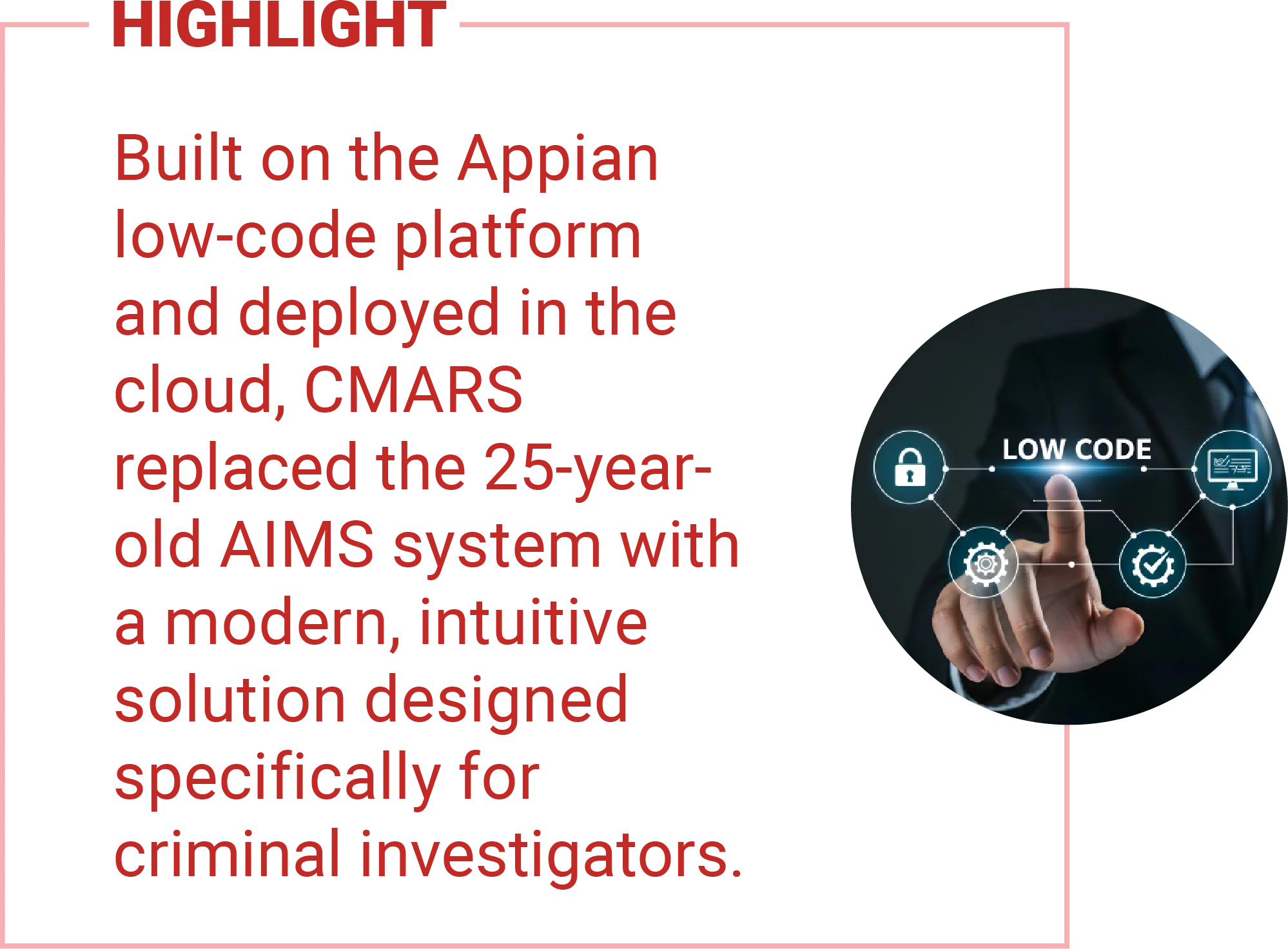Background:
The Food and Drug Administration’s mission is to protect and promote public health by assuring the safety, efficacy, and security of human and veterinary drugs, biological products, medical devices, our nation’s food supply, cosmetics, and products that emit radiation. This mission-critical responsibility directly safeguards the health and welfare of millions of Americans who rely on FDA-regulated products every day.
As FDA’s criminal law enforcement arm, the Office of Criminal Investigations (OCI) protects the American public by conducting criminal investigations of illegal activities involving FDA-regulated products, arresting those responsible, and bringing them before the Department of Justice for prosecution. OCI Special Agents are dedicated to protecting the health and welfare of the public by investigating criminal allegations falling within the FDA’s jurisdiction.
Challenge:
The FDA’s Office of Criminal Investigations faced a critical technology gap that was undermining its mission to protect public health. For over 25 years, investigators relied on the Automated Investigative Management System (AIMS)—an Oracle Forms application that had never been modernized. This outdated system created challenges for agents investigating crimes involving counterfeit drugs, contaminated food, and other threats to American consumers.
The legacy system’s limitations were hindering effective case management at every level. Investigators were unable to efficiently link related cases or subjects, forcing them to correlate information across fragmented data sources manually. Basic functions, such as comprehensive case documentation, were compromised by technical restrictions, requiring agents to use external systems for detailed records. Navigation was cumbersome and time-consuming, with investigators spending hours searching through disconnected screens to find critical information. These inefficiencies were not just frustrating—they were directly impacting the speed and effectiveness of criminal investigations that protect public health.
Beyond operational challenges, AIMS posed a serious business continuity risk. The 25-year-old Oracle Forms technology had reached end-of-life with no vendor support, and finding developers capable of maintaining the legacy code was becoming nearly impossible. The FDA needed a modern solution that would not only eliminate these operational barriers but also provide a sustainable technology foundation for future criminal investigation needs.
Solution:

The development focused on eliminating the operational barriers that hindered investigators daily. REI conducted a comprehensive requirements analysis with subject matter experts, creating detailed user personas and mapping over 50 distinct workflows to ensure every aspect of the criminal investigation process was optimized. Using Human-Centered Design principles, the team developed intuitive interfaces that maintain context across screens, implemented robust search capabilities, and created seamless data linking, allowing investigators to connect cases efficiently, subjects, and evidence without manual workarounds.
CMARS was built with enterprise-grade security and scalability requirements in mind. The system achieved FISMA High classification to handle top-secret criminal investigation data, incorporating multi-factor authentication, single sign-on (SSO) integration, and comprehensive data encryption. The cloud-native architecture provides the scalability and reliability required for mission-critical operations, aligning with the FDA’s Technology Modernization Action Plan (TMAP) for sustainable, future-ready infrastructure.
Following rigorous testing and comprehensive user training, CMARS was launched successfully in February 2025, immediately transforming how FDA investigators document, manage, and prosecute criminal cases. The new system eliminated the fragmented workflows and technical limitations of the legacy platform, enabling investigators to focus on their core mission of protecting public health rather than wrestling with outdated technology.
Business Impact:
The implementation of CMARS has transformed OCI’s operational capabilities, enabling the processing of more cases with greater speed and accuracy. The modernized system facilitates rapid information retrieval, streamlines report generation, and enhances the understanding of data relationships, resulting in improved decision-making capabilities and significantly increased efficiency and productivity across all investigative activities.
Operational Improvements:
- Enhanced Data Integrity: Enforced business rules ensure user inputs comply with
specific standards and requirements, preventing entry of non-compliant data and maintaining
investigation quality - Streamlined Workflows: Modernized business processes eliminate redundancies and automate routine tasks
- Enhanced User Experience: Modern, intuitive interface design reduces training time and
improves user satisfaction - Advanced Reporting: Sophisticated reporting features provide deeper insights into investigation patterns and outcomes
 Strategic Outcomes:
Strategic Outcomes:
The modernization of the FDA’s Criminal Investigation System marks a pivotal advancement in the agency’s ability to protect public health through more effective law enforcement. By removing outdated technology barriers and streamlining investigative processes, the new Case Management and Administrative Resource System enables OCI to operate with greater speed, accuracy, and impact.
More than just a system replacement, the launch of CMARS represents a strategic shift in how the FDA approaches digital innovation. In partnership with REI Systems, the agency replaced decades-old legacy technology with a secure, low-code platform tailored to the needs of criminal investigators. The result is a future-ready solution that strengthens the FDA’s investigative capabilities and ensures OCI agents can continue safeguarding the American public with confidence and efficiency.



 Strategic Outcomes:
Strategic Outcomes:

